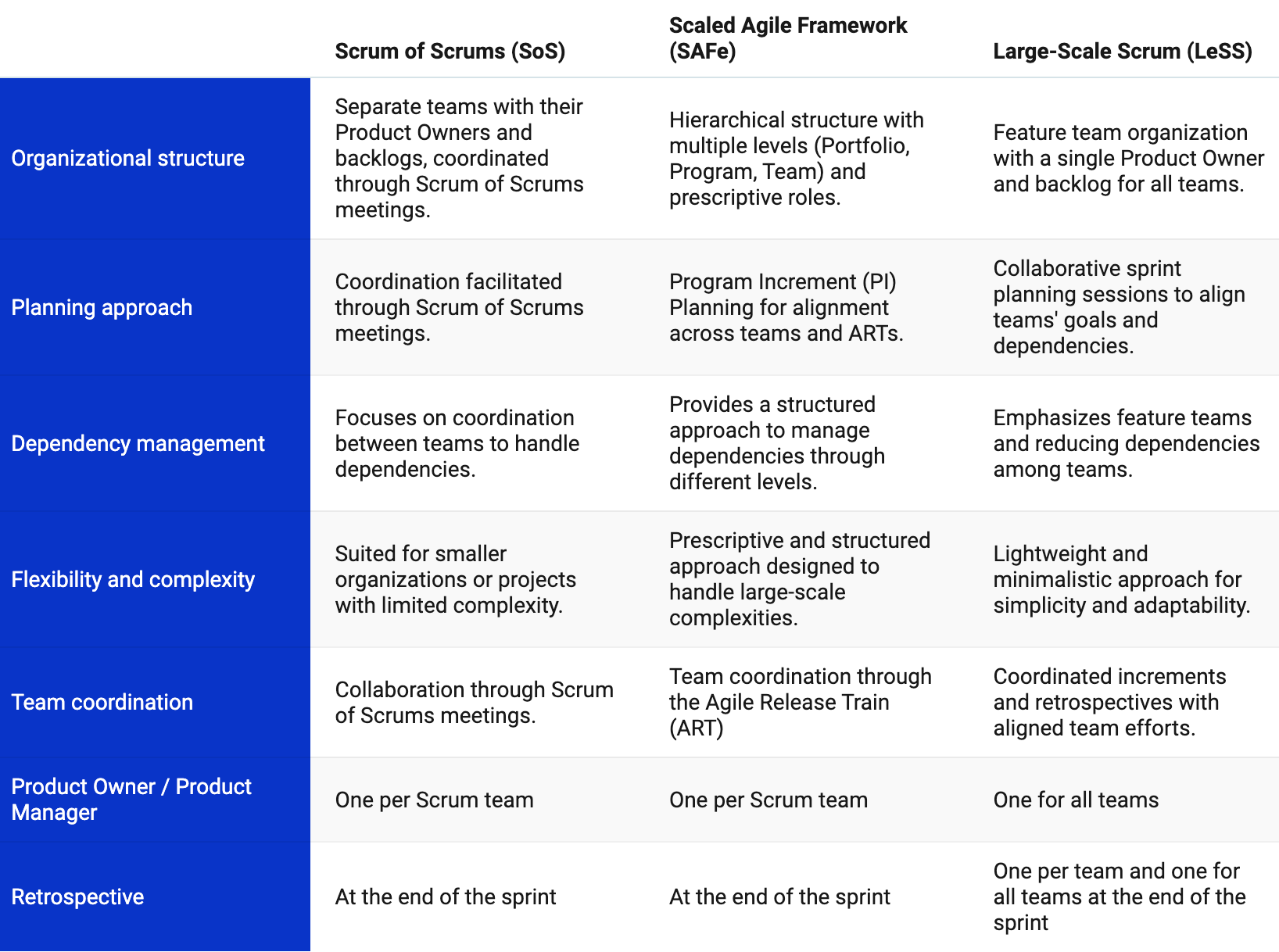In the technology industry, when discussing software development projects, terms like Agile, Scrum, Lean, and other related Agile frameworks immediately come to mind, especially for those involved in project teams.
Scrum, being one of the most popular frameworks, involves compact teams of 4 to 7 members who efficiently address business needs by breaking down substantial workloads into smaller tasks. Teams continuously deliver these tasks incrementally, generating value from the early stages of product development.
But how can companies organically grow their projects and products? How can an Agile project team scale successfully? Project Managers play a vital role in analyzing different methods to meet evolving user and business needs while also being able to modify their strategy and be flexible.
Scaling Agile: embracing frameworks for enhanced efficiency and organizational agility
Luckily, nowadays we can find different frameworks and methodologies that set guidelines for scaling Agile teams, allowing us to have a model that we can adapt to our own way of working. Let's now delve into some of the most renowned ones.
Scrum of Scrums (SoS): empowering cross-team synergy
Scrum of Scrums, or SoS, is a natural choice for companies already using Scrum. This technique maintains the core principles, ceremonies, artifacts and guidelines of Scrum while enhancing coordination among multiple teams to generate integrated value at the end of each sprint.
To achieve this, SoS divides a large Scrum team (with more than 8 members) into smaller Scrum teams (typically 4 members). Each team conducts its regular Scrum ceremonies, complemented by Scrum of Scrums meetings. Here, a delegate from each team attends on their behalf to communicate, align, and coordinate the work being developed by each Scrum team. This collaborative effort ensures an integrated and functional product deliverable upon each sprint's conclusion.

Scaled Agile Framework (SAFe): a path to enterprise agility
SAFe, short for Scaled Agile Framework, is a powerful system that combines Lean and Agile principles to bring agility to large organizations handling complex software projects with numerous dependencies. This framework can be applied at different levels within the organization: Team, Program, Large Solution, and Portfolio:
- At the Team level, individual Agile teams adopt methodologies like Kanban, Lean, or Scrum to manage their work efficiently.
- The Program level focuses on coordinating multiple Agile teams. An Agile Release Train (ART) is then created to facilitate this. ARTs consist of cross-functional Agile teams that work collaboratively to break down complex projects into smaller, more manageable parts. This dynamic allows teams to align to business strategies, track progress, deliver incremental product and often operates one or more solutions in a synchronized manner.
- The Large Solution level tackles the complexities of coordinating multiple ARTs to deliver broader initiatives. It involves creating a set of ARTs that collaborate to achieve a common goal. This level ensures harmonization of work across different ARTs and seamless integration of the overall solution.
- Finally, at the Portfolio level, the organization's vision, financing, value streams, and governance for all ARTs are managed, ensuring a cohesive and strategic approach to Agile implementation.
Large-Scale Scrum (LeSS): simplifying Agile for big projects
Large-Scale Scrum (LeSS) is a lightweight approach that scales Scrum to multiple teams while maintaining simplicity. It focuses on user needs and works to reduce processes to an absolute minimum. This methodology typically works best when used by up to 8 Scrum teams.
In LeSS, there is a single Product Owner and backlog, promoting a unified vision and clear priorities across teams. The framework emphasizes feature team organization, where all teams work on the same product, eliminating sub-teams or component teams.
LeSS focuses on effective collaboration through its core ceremonies and minimizes additional meetings to reduce complexities. Collaboration is facilitated through two sprint planning sessions, one for all the teams and a second one at a team level, ensuring alignment of goals and dependencies. LeSS also fosters coordinated increments and retrospectives, where all teams work with sprints of the same duration and deliver integrated product increments at the end of each sprint. At the conclusion of each sprint, two retrospective sessions are held—one at the team level and another between teams—to facilitate knowledge sharing and continuous improvement.

A comparative overview
To sum up, these are the high-level differences between frameworks:

Tailoring Agile practices for enhanced team performance
Implementing Agile practices requires acknowledging that there is no magic formula or guaranteed recipe for success. It involves transforming the organization's mindset and finding the right approach for your teams, which may take time and require trial and error. To start, align the company's mindset at all levels and gradually introduce scaling tools for improved agility.
For teams at a lower maturity level, practices like Scrum of Scrums (SoS) or Large-Scale Scrum (LeSS) may feel more natural, especially if they are already using Scrum. On the other hand, the Scaled Agile Framework (SAFe) is more suitable for larger teams and aims to create a broader organizational impact.
As a business stakeholder interacting with project managers, your role is crucial in supporting their efforts to find the most effective Agile tools for generating value. Encourage them to explore and experiment with different frameworks, allowing them to adapt practices that best fit their teams' culture and pace. Remember, there is no one-size-fits-all approach; success lies in discovering what works best for your project and organization.
If you are a project manager, embrace the opportunity to experiment and tailor Agile practices to suit your teams and projects. Seek feedback from stakeholders and business leaders to align your approach with organizational goals. Foster a culture that empowers teams to adapt and evolve. By honing your listening skills, conducting thorough context analysis, and adopting an experimentation mindset, you can create an environment where Agile principles thrive, empowering your teams to reach peak efficiency and unleash their full potential. With the right approach, you can unlock enterprise agility and drive business success.



